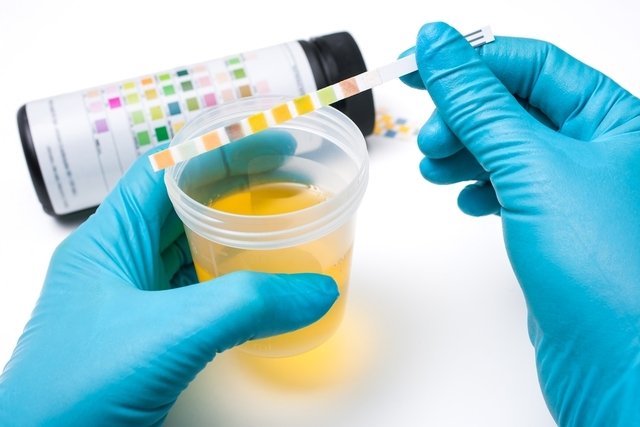The presence of protein in urine in high levels may be a sign of kidney problems, hypertension or diabetes. It is often referred to as proteinuria.
The kidneys filter the blood, and substances that the body needs are reabsorbed, while substances the body doesn‘t need are eliminated through the urine. In some conditions, the kidneys allow the protein to pass through its filters, which increases protein levels in the urine.
When protein is not associated with any specific symptoms or other conditions, it is considered to be isolated proteinuria, which can be a consequence of stress or intense physical activity.

Causes and types of proteinuria
Increased levels of protein in the urine can occur for many reasons. The types of proteinuria can be classified based on the underlying cause and duration of the condition. The types are as follows:
1. Transient proteinuria
It is possible to experience temporary increases of protein in the urine with any of the following conditions:
- Dehydration
- Emotional stress
- Exposure to extreme cold
- Fever
- Intsense physical activity
These situations are not of clinical concern and usually resolve on their own.
2. Orthostatic proteinuria
With orthostatic proteinuria, protein levels in the urine increases when you are standing for prolonged periods of time. This is usually observed in children and young adults who are tall and lean. Protein secretion mainly occurs during the day, when levels are higher. Therefore, urine that is collected in the morning will usually contain little to no protein.
3. Persistent proteinuria
Illnesses and conditions that are associated with persistently high levels of protein in the urine include:
- Amyloidosis, which consists of an abnormal accumulation of protein in different organs
- Prolonged use of medications, like non-steroidal anti-inflammatories
- Chronic renal disease, chronic polycystic renal disease, or a kidney infection
- Heart disease or an infection of the cardiac lining
- Hodkin’s lymphoma and multiple myeloma
- Glomerulonephritis, which consists of inflammation of the renal glomeruli
- Diabetes, which affects a person’s ability to filter the blood and reabsorb protein
- High blood pressure, which damages the arteries within and surrounding the kidneys, which can negatively affect renal function
- IgA nephropathy, which consists of renal inflammation from an accumulation of immunoglobulin A antibodies
- Sarcoidosis, which consists of the growth and development of inflammatory cells in the organs
- Sickle cell anemia
- Lupus
- Malaria
- Rheumatoid arthritis
High levels of protein in the urine can occur during pregnancy, and is related to many diverse factors like increased work in the kidneys to filter more fluids, excess stress, UTIs, or in more serious cases, pre-eclampsia.
Pre-eclampsia is a serious complication of pregnancy, and should be detected as soon as possible to prevent any risks to the mother or baby’s health. It is associated with increased blood pressure, headache and swelling.

Possible symptoms
Protein in the urine can be a result of many diverse situations, therefore it does not cause any specific symptoms. Symptoms are usually related to the conditions that cause it.
If proteinuria is related to kidney disease, you may also notice symptoms like nausea or vomiting, decreased urine production, ankle swelling, bitter taste in the mouth, fatigue, shortness of breath, lack of appetite, pallor, thirst and itching. Urine may also be noted to be foamy, and some people may additionally report burning with urination. Learn more about what can cause foamy urine.
Treatment depends on the underlying cause, therefore you should see a doctor to determine the diagnosis, which will guide the treatment options.
Confirming a diagnosis
Protein can easily be detected in the urine through a urine routine and microscopy (also known as a urine R&M) or through a urine dipstick. The dipstick will usually change colors in the presence of high protein levels.
If high levels of protein have been found in the urine, the doctor may additionally order a 24 hour urine test, so that protein and creatinine can be tested. These tests will look at kidney function to investigate for any illnesses.
How to prepare for the test
Before completing the test, speak to your doctor about how to prepare yourself for it to ensure accurate results. Some patients may need to hold or discontinue supplements that could interfere with the results of the urine tests.
Other factors that can impact the test results include dehydration or not drinking enough water, using contrast for an imaging test, emotional or stressful situations, extreme exercise, a UTI, or urine contaminated with vaginal secretions, blood or semen.
Women who are menstruating should wait 5 to 10 days after finishing their period to collect urine, to avoid urine contamination with menstrual blood.
